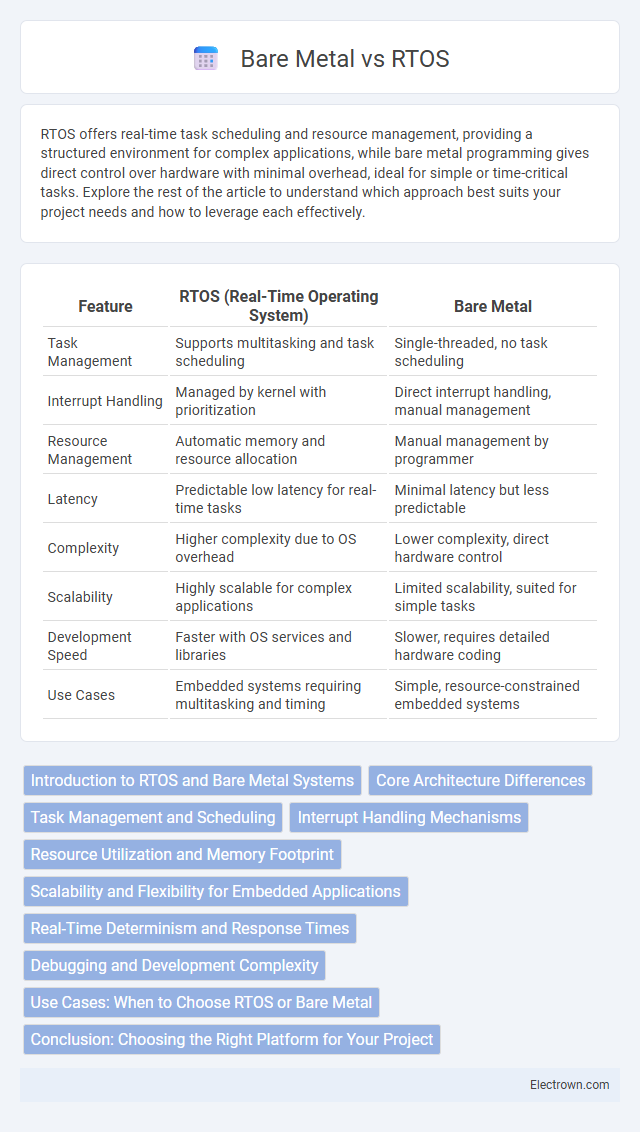RTOS offers real-time task scheduling and resource management, providing a structured environment for complex applications, while bare metal programming gives direct control over hardware with minimal overhead, ideal for simple or time-critical tasks. Explore the rest of the article to understand which approach best suits your project needs and how to leverage each effectively.
Table of Comparison
| Feature | RTOS (Real-Time Operating System) | Bare Metal |
|---|---|---|
| Task Management | Supports multitasking and task scheduling | Single-threaded, no task scheduling |
| Interrupt Handling | Managed by kernel with prioritization | Direct interrupt handling, manual management |
| Resource Management | Automatic memory and resource allocation | Manual management by programmer |
| Latency | Predictable low latency for real-time tasks | Minimal latency but less predictable |
| Complexity | Higher complexity due to OS overhead | Lower complexity, direct hardware control |
| Scalability | Highly scalable for complex applications | Limited scalability, suited for simple tasks |
| Development Speed | Faster with OS services and libraries | Slower, requires detailed hardware coding |
| Use Cases | Embedded systems requiring multitasking and timing | Simple, resource-constrained embedded systems |
Introduction to RTOS and Bare Metal Systems
Real-Time Operating Systems (RTOS) provide multitasking capabilities, deterministic task scheduling, and resource management essential for time-critical embedded applications, ensuring predictable response times. In contrast, bare metal systems run directly on hardware without an operating system, offering minimal overhead and maximum control, often used in simple or performance-critical projects. Choosing between RTOS and bare metal depends on application complexity, timing requirements, and available system resources.
Core Architecture Differences
RTOS (Real-Time Operating System) features a layered core architecture with a scheduler, multitasking capabilities, and inter-task communication mechanisms, enabling predictable timing and resource management. Bare metal programming runs directly on hardware without an OS layer, relying on simple, sequential code execution and manual interrupt handling. Understanding these core architecture differences helps you optimize system design for timing precision and resource constraints.
Task Management and Scheduling
RTOS provides sophisticated task management and preemptive scheduling, enabling multiple tasks to run concurrently with precise timing and priority control. Bare metal programming relies on a single-threaded execution model or simple cooperative multitasking, limiting responsiveness and scalability in complex applications. Your choice impacts real-time performance, as RTOS ensures timely task switching and resource allocation, while bare metal demands manual control and can struggle with managing multiple tasks efficiently.
Interrupt Handling Mechanisms
Interrupt handling mechanisms in RTOS provide prioritized, preemptive multitasking with well-defined interrupt service routines (ISRs) that allow for deterministic response times and efficient context switching. Bare metal systems rely on simpler, often non-preemptive interrupt handling, which can lead to longer latency and increased complexity in managing multiple interrupts, especially as application complexity grows. Understanding these differences helps you design responsive embedded systems optimized for your real-time needs.
Resource Utilization and Memory Footprint
RTOS typically requires more memory and CPU resources compared to bare metal development due to its kernel services, task scheduling, and inter-task communication features. Bare metal programming offers minimal memory footprint and efficient resource utilization by running code directly on hardware without an operating system layer. You should choose bare metal when your application demands lean resource usage, while RTOS suits complex systems needing multitasking and real-time responsiveness.
Scalability and Flexibility for Embedded Applications
RTOS offers superior scalability and flexibility for embedded applications by enabling multitasking, resource management, and real-time scheduling, which allows efficient handling of complex and varying workloads. Bare metal programming provides minimal overhead and deterministic performance but lacks the modularity and dynamic task management capabilities inherent in RTOS environments. Selecting RTOS facilitates easier feature expansion and adaptation to evolving hardware requirements, making it ideal for scalable, flexible embedded system designs.
Real-Time Determinism and Response Times
RTOS (Real-Time Operating System) provides deterministic response times by managing task scheduling and prioritization, ensuring critical tasks meet strict timing constraints. In contrast, bare metal programming offers minimal overhead and faster interrupt handling but lacks built-in mechanisms for guaranteed real-time scheduling. RTOS achieves predictable latency through preemptive multitasking and interrupt management, while bare metal relies on simple, application-specific timing control without the complexity of an operating system.
Debugging and Development Complexity
RTOS simplifies debugging and development by providing structured multitasking, standardized APIs, and real-time scheduling, which help isolate and identify issues more systematically. Bare metal development offers lower overhead and tighter hardware control but increases complexity due to manual management of timing, interrupts, and resource conflicts, making debugging more challenging. Tools like trace analyzers and RTOS-aware debuggers significantly enhance fault detection in RTOS environments compared to bare metal systems.
Use Cases: When to Choose RTOS or Bare Metal
RTOS is ideal for complex applications requiring multitasking, real-time responsiveness, and resource management, such as industrial automation, medical devices, and robotics. Bare metal suits simple, cost-sensitive projects with minimal processing needs, where direct hardware control and low latency are critical, like basic sensors or simple embedded systems. The choice depends on application complexity, timing requirements, and available system resources.
Conclusion: Choosing the Right Platform for Your Project
Selecting between RTOS and bare metal depends on your project's complexity and real-time requirements. RTOS offers multitasking and built-in resource management ideal for complex, time-sensitive applications, while bare metal provides maximum control and efficiency suited for simple, latency-critical tasks. Evaluate your system's scalability, development time, and maintainability to make the best platform choice.
RTOS vs bare metal Infographic

 electrown.com
electrown.com